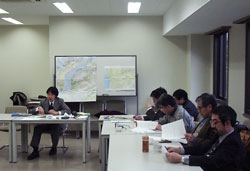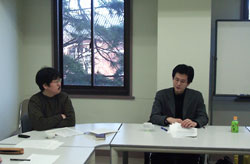

Co-hosted by Date: March 8, 2003 Venue: East Hall, Faculty of Letters, Kyoto University Presentation 1: Muslim Saint Worship Reconsidered: Some Pointers to Various Aspects of "Saint" Connections among the Berbers of South-western Morocco Reporter: ARAI Kazuhiro (ASAFAS, Kyoto University) The enthusiastically supported research meeting on Muslim saints was held jointly by the above-mentioned three research groups, and was attended by about 30 people. Mr Saito has been working mainly on the Inddouzzal, a Berber tribe of southern Morocco, and has spent the lengthy period of four years engaged in field investigations. Mr. Saito, who had brought back a great deal of information from the field, focused his efforts in his presentation on the reconsideration of "saint worship." As regards research on "saint worship," scholars have tried various approaches combining sociology with Islamic studies. Mr Saito has investigated "saint worship" in its broad social context. His work is an attempt to construct a new image of the "saint" that is stipulated according to the connections between people and the world in which they live. First, Mr Saito introduced some examples of "saints" from the villages in which he had undertaken his research.
After discussing the above individuals, who even by past standards can be recognised as "saints," Mr Saito introduced the "religious personality" connected with the villages he had investigated. He pointed out that the characteristics of such a personality comprise an intellectual disposition, foreignness, experience of the outside world, and mobility from one place to another. Reference was also made to the following:
We would like to keep an eye on Mr. Saito's future papers, to see how he develops his approach under which he places the "religious personality" as a superordinate concept of the "saint." By OTOSHI Tetsuya (Kyushu University) Reporter: IMAMATSU Yasushi (Kobe University) In this presentation, Mr. Otoshi, who clarified various aspects of the Egyptian social phenomenon, ziyara, discussed tasawwuf through a group of literature called the Books of ziyara. Mr. Otoshi first discussed a historical background of each volume of the Books of ziyara and also how sufis were perceived in each time period. Then he went on to examine connections between the Books of ziyara and sufis. In the course of examination, he focused on the following:
In order to discuss this subject further, we must ask ourselves, "What attributes make people sufis?" Mr. Otoshi explored this question in great detail, specially while examining the first point. Next, Mr. Otoshi discussed what he found in the Books of ziyara from the following six aspects:
We can not talk about sufism, tariqa, and saint worship, without understanding ziyara, a manifesting point of saint worship. This presentation was intriguing and worthwhile because, without ignoring how ziyara was perceived in "A theory regarding the tri-polar structure of Sufism" by Mr. TONAGA Yasushi, Mr. Otoshi discussed connections between tasawwuf and ziyara based on his painstaking research through the extraordinary amount of reading. |
| Back |
|
|
 21st COE Program
21st COE Program Presentation 2: Tasawwuf as seen from "Books of Ziyara" -Raising the Issues from the Periphery
Presentation 2: Tasawwuf as seen from "Books of Ziyara" -Raising the Issues from the Periphery